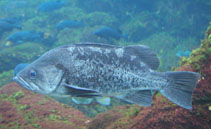| Family: |
Sebastidae (Rockfishes, rockcods and thornyheads), subfamily: Sebastinae |
| Max. size: |
63 cm TL (male/unsexed); max.weight: 4,800.0 g; max. reported age: 50 years |
| Environment: |
reef-associated; marine; depth range 0 - 366 m |
| Distribution: |
Eastern Pacific: Amchitka Island, Aleutian Islands, Alaska to Paradise Cove, Baja California, Mexico. |
| Diagnosis: |
Dorsal spines (total): 13-14; Dorsal soft rays (total): 13-16; Anal spines: 3-3; Anal soft rays: 7-9; Vertebrae: 26-26. Head spines weak to very weak - nasals present, preocular and postocular spines usually absent, supraocular, tympanic, coronal, parietal and nuchal spines absent (Ref. 27437). Symphyseal knob very weak or absent (Ref. 27437). Eyes moderately large (Ref. 27437). Anal fin profile rounded or with greater portion slanted posteriorly (Ref. 27437). Posterior margin of caudal fin indented (Ref. 27437). Dark grey to black with light grey mottling dorsally, lighter ventrally (Ref. 27437). Branchiostegal rays: 7 (Ref. 36715). |
| Biology: |
Found near rocky reefs in shallow water and in open water over deep banks (Ref. 2850). Adults live both off and on bottom (Ref. 2850). Juveniles are pelagic (Ref. 36715). Form schools (Ref. 2850). Feed on fishes (Ref. 27302). Viviparous, with planktonic larvae (Ref. 36715). Young are important prey species for other fishes, marine mammals and birds. Excellent food fish (Ref. 27436). |
| IUCN Red List Status: |
Not Evaluated (N.E.) Ref. (130435)
|
| Threat to humans: |
harmless |
Source and more info: www.fishbase.org. For personal, classroom, and other internal use only. Not for publication.
